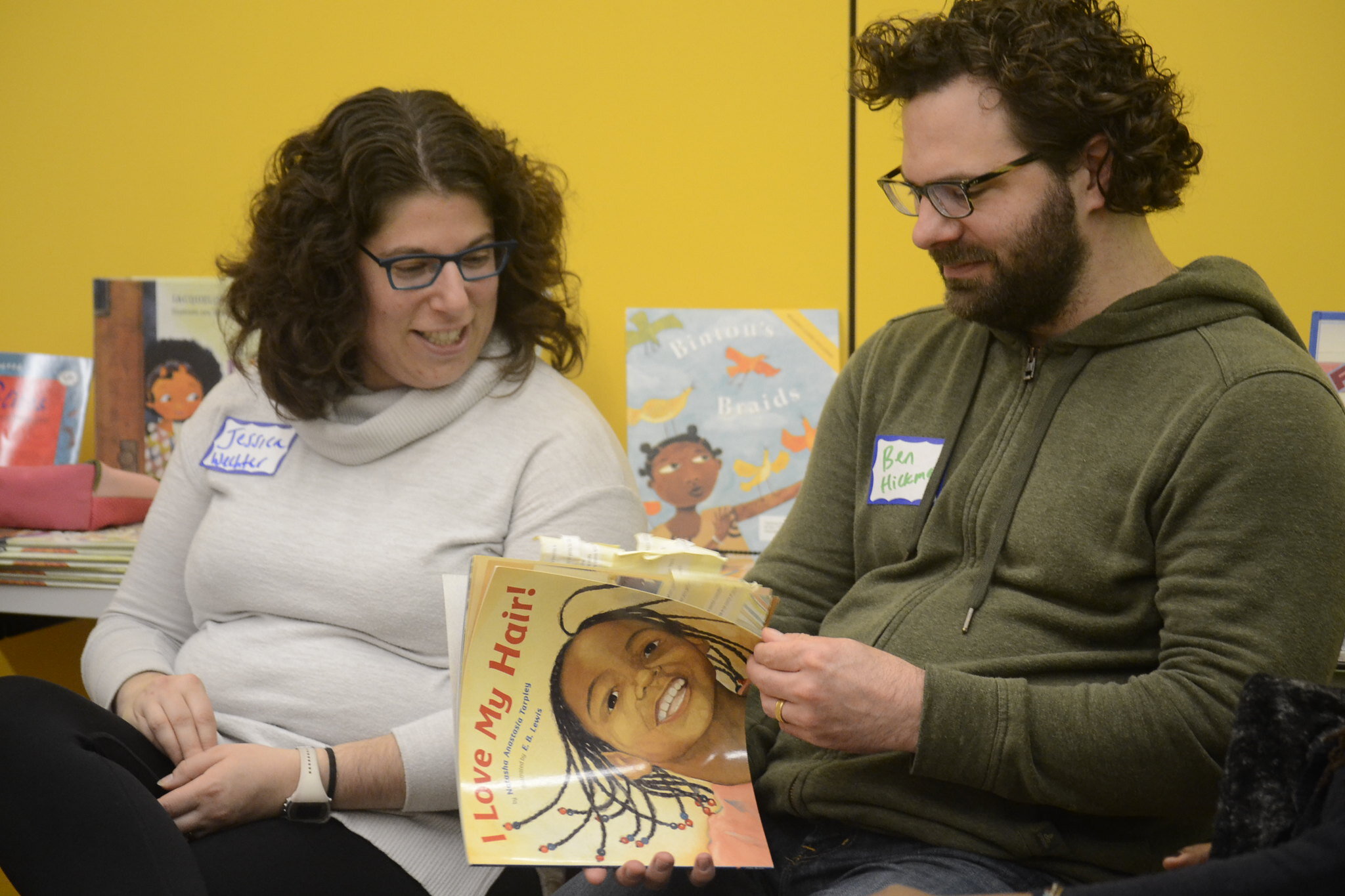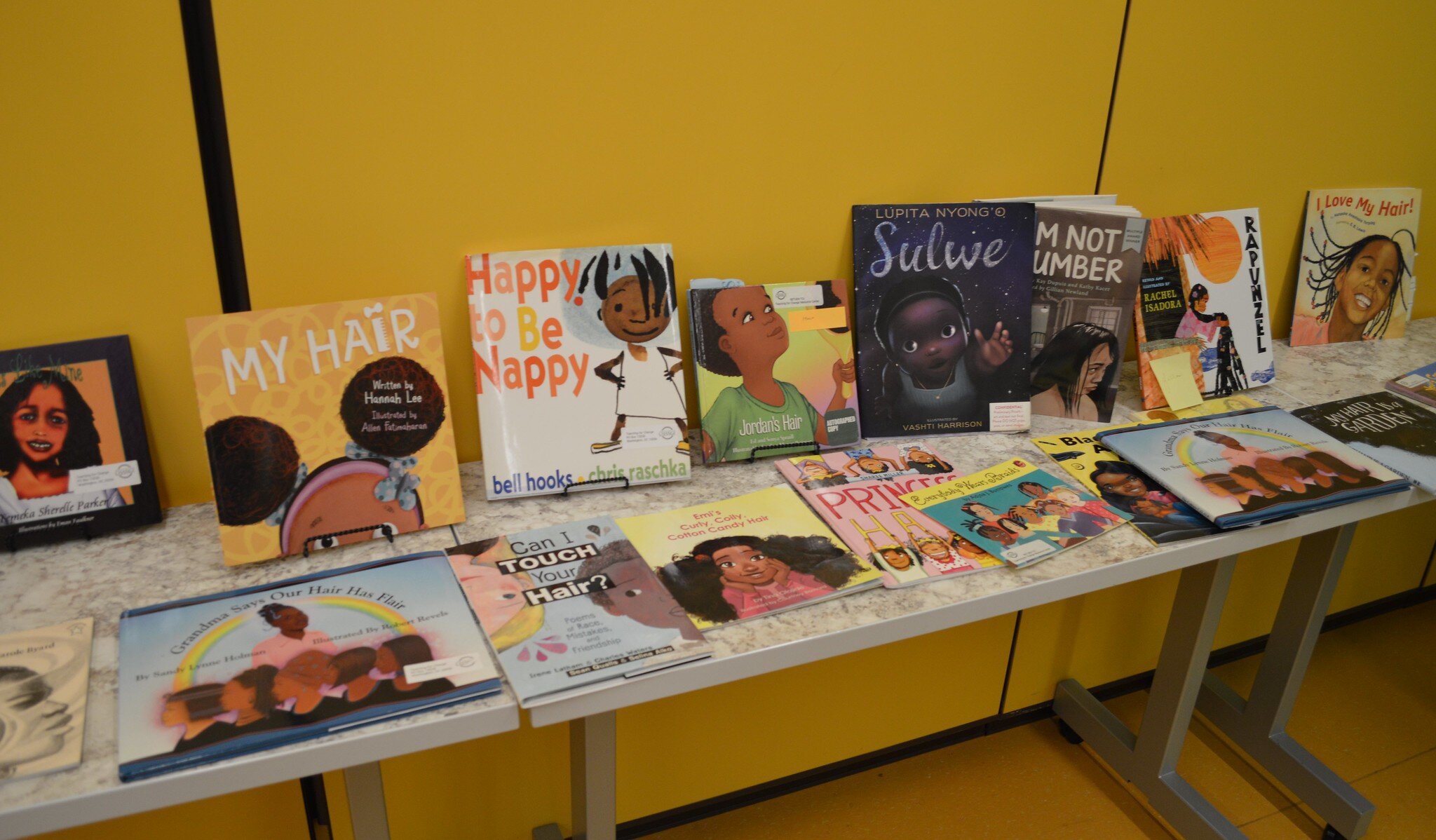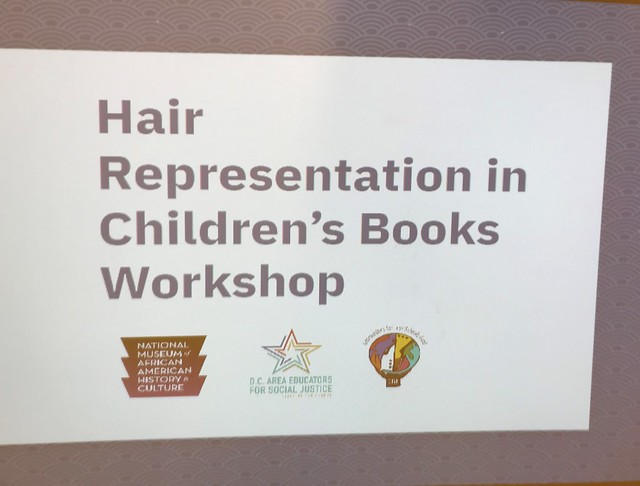Hair Representation in Children’s Literature
Teaching for Change Offers Workshop at National African American Museum of History and Culture
In 2013, then 12-year old Vanessa VanDyke was threatened that she would be expelled unless she cut her natural hair because it was regarded as a “distraction” by administrators. In 2017, sisters Mya and Deanna Cook were told if they did not get rid of their braids, they would be removed from extracurricular activities, banned from prom, and given detention. In 2018, Drew Johnson was publicly forced to cut his locs in order to participate in a wrestling tournament or forfeit his match. In classrooms and schools across the country, we have also seen posted signs that designated which hairstyles were deemed appropriate and which were not, many of those hairstyles traditionally worn by people of color.
In light of these and other incidents, Teaching for Change’s D.C. Area Educators for Social Justice, Communities for Just Schools Fund, and the Early Childhood Initiative at the National Museum of African American History and Culture offered a workshop on hair representation in children’s books on November 2, 2019. The workshop was designed and facilitated by myself and Teaching for Change Coordinator of Teacher Engagement and Professional Development Rosalie Reyes.
This might be my favorite reaction video of all time. Look at this little ones reaction once she opens her @hairlovemovie picture book and sees herself in the main character. Turn on audio. #RepresentatiionMatters @vashtiharrison @kokilabooks
— Matthew A. Cherry (@MatthewACherry) September 7, 2019
Credit: https://t.co/bvFYuyguPm pic.twitter.com/yN35AKj150
More than 25 educators, administrators, and education advocates from across the D.C. metro area participated in a two-hour workshop around the historical and sociopolitical context of hair, selecting children’s books on hair, and how to highlight these lessons and conversations in the classroom. To build community and to encourage networking between attendees, we opened the workshop with a story fortune icebreaker activity. Each attendee received a slip of paper with a prompt that they would then have to share with a partner. A few story fortune prompts included: my favorite hairstyle, why I am interested in children’s literature, and a teacher or book that helped me rethink issues of race, gender, or class.
After participants spent some time learning more about one another, we introduced the first lesson. We adapted Bill Bigelow’s The Color Line into The Hair Line, to predict and discuss policies, practices, and symbolism around hair. Through the lesson, participants analyzed the ways that hair has been used throughout history to make a statement, tell a story, and to control and create racial hierarchy through messages of inferiority/superiority. Groups then had an opportunity to predict and share examples in smaller conversations, later reviewing another worksheet, which detailed multiple examples throughout history. We moved from grounding ourselves in the historical context to thinking about how the pervasiveness of hair policies, and in some cases, the lack thereof, contribute to current practices in schools.
One example that inspired deep group discussion was about the findings from the National Women’s Law Center’s report on D.C. codes. The study found that 68 percent of D.C. public high schools that publish their dress codes online ban headwraps or hair scarves. A few school dress codes local to the D.C. metro area have policies, such as “No hats, hair rollers or curlers are allowed during the school day or at school-sponsored activities,” and “Headwear is not permitted. This includes but is not limited to hats, visors, bandannas, scarves, bonnets, and hoods. (Exceptions may be granted based on religious and medical reasons with proper verification).” This sparked conversation about how those policies have been ingrained in our practices in the classroom. The topic also inspired questions about how we find balance between honoring students’ expression and abiding by safety regulations that are set forth by school districts and school boards.
After situating and emphasizing the importance of grappling with the historical and sociopolitical context of hair, we discussed current examples that show the power of representation in children’s literature. One of the examples we highlighted was Matthew Cherry’s Hair Love, illustrated by Vashti Harrison. This sweet tale shares the story of Zuri, who is trying to figure out what to do with her hair for a special occasion. With her dad’s help, they figure out the perfect solution after a few challenges along the way. We showed the short animated film clip, adapted from the book, alongside the below reaction from a child that sees an image of themselves reflected in the pages of the book. This illustrates the power, beauty, and magic of representation.
Using the book and clip as tools to spark an introductory conversation with early childhood and elementary students, we also encouraged educators to pose questions with students such as,
Do you have someone who does your hair?
Was there a time you did your hair really special?
What is your favorite thing about your hair?
Representatives from Curlanista were also in attendance and they graciously detailed the origin story of the company and talked about the company’s founder, Lexi P., who launched the CURLANISTAS BO$$ Network, a youth entrepreneurial program. Dannika Stith-Bowers, an educator herself, brought her three daughters, Layla, Logan, and Leah, to talk about representation and the importance of being able to see themselves reflected in hair care products and books. Stith-Bowers encourages her daughters to select hairstyles they like and they will often point out pictures in books to show how they would like their hair. Each of the girls hugged a book as they sat in front of the room — one a Curlanista coloring book that featured a number of natural styles and textures, another one a notebook to showcase her exquisite drawings, and the other a detailed journal. As Stith-Bowers described each of the girls’ different styles for how they like to wear their hair, she also offered a meaningful note,
When my daughter goes to school and isn’t happy with her outfit or her hair that day, her teacher talks to her and affirms that she is beautiful just the way she is.
Children’s books offer a dynamic and influential mirror for them to feel affirmed, celebrated, and appreciated. One way that the affirmation of hair can show up in a lesson is through reader’s theatre, another lesson we shared with the group. Using some guiding questions created by Roving Readers, we asked some pre-reading questions, including,
Why do you love your hair?
How does it feel when someone is doing your hair or when you get a haircut?
After that, we had attendees break into small groups and asked them to select three pages of the book I Love My Hair! to act out to the larger group. This reader’s theatre lesson can be adapted for different age groups in a number of ways. For example, for the youngest readers, educators or family members can read to them and have them act out each page. For older readers, they can read the book and either create a new scene to act out or write a related scene about their own experiences if this is something they would like to share. After reading the book, we followed up with some additional questions and statements, including,
Why do you think Keyana loved her hair?
What can you do with your hair?
Now everyone say I LOVE MY HAIR!
Opportunities to not only see different types and textures of hair represented in classroom content, but to also engage in discussion with students about their own hair practices helps to break down the barriers that ‘others’ hair that has historically been missing from mainstream media. Carefully selecting children’s books can play a significant and powerful role in helping shape young children’s perspectives about themselves and about others. Through read-alouds, role play, discussion, and other activities, children begin to build empathy and also a sense of confidence in their ability to understand and honor others’ experiences. Interacting with children’s books helps students with different learning styles comprehend and celebrate all dimensions of human difference, such as engaging with pictures as visual learners, listening as auditory learners, acting out the characters as kinesthetic learners, or talking through their thoughts as verbal learners.
We ended the workshop by giving participants an opportunity to look through some of the children’s books on hair we curated and compiled. Some of the books included Crown: An Ode to the Fresh Cut, I Am Not a Number, My Hair is a Garden, and Bad Hair Does Not Exist! Pelo Male No Existe! Each participant received a guiding questions resource sheet for selecting children’s books on hair. The resource sheet provided guiding questions and tips for critical selection. Some of the guidance included,
Check the illustrations. What hair textures and styles are missing or invisible? How are you able to supplement those conversations when reading books with children?
Consider how the books might affect children’s self and social identity. Then selecting children’s books on hair, does your collection incorporate or include different ethnicities? For example, are Afro-Latinx communities, indigenous communities, or communities that cover their hair represented in the text?
The time to explore the books also created space for educators to get together and share their expertise in discussing how they would incorporate some of these books into their classes or turn the book into a lesson, using some of the framework from the reader’s theatre as a starting point.
Attendees shared their thoughts about what they learned during the workshop,
I realized how much there is to explore about hair. It is so complex, historically and currently. Literature is such a great starting point for the conversation.
Loved guiding questions and history handouts. Appreciated all of the books to peruse. I liked the intersectionality lens (gender, faith, etc.)
The resources were wonderful. I hadn’t thought about all of the laws and policies around hair. The sample lessons / questions were good. Thank you.
I think the most important thing I gained from today was the opportunity to reflect on my experience with hair, the experience of others, and the historical experience in regard to hair representation.
Through discussion and interactive lessons and activities, this workshop extended the national conversation about what it means to affirm, celebrate, and honor different types and textures of hair, namely natural hair, while providing a historical context to ground our teaching and learning.
The team is based in Washington, D.C. and the presenters are available to present at conferences, for professional development, or for teacher education courses. If interested, please contact Cierra Kaler-Jones at ckalerjones@cjsfund.org.
VIEW MORE PHOTOS FROM EVENT
Cierra Kaler-Jones is the Education Anew Fellow with Communities for Just Schools Fund and Teaching for Change. She is also a Ph.D. candidate at University of Maryland, College Park studying minority and urban education.








